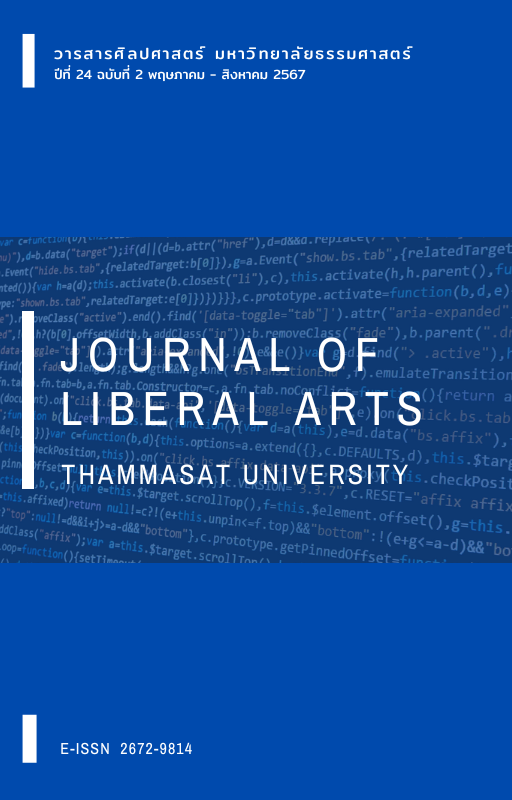การค้นหาชาวตันกา : ประวัติศาสตร์ชาวตันกาในจังหวัดสุราษฎร์ธานี
Main Article Content
บทคัดย่อ
บทความนี้มีวัตถุประสงค์เพื่อศึกษาตำนานและประวัติศาสตร์ชาวตันกา การอพยพและการตั้งถิ่นฐานของชาวตันกา อัตลักษณ์จีนตันกา และความสัมพันธ์ระหว่างชาวจีนตันกากับชาวจีนกลุ่มอื่น ๆ ในจังหวัดสุราษฎร์ธานี โดยใช้ระเบียบวิธีวิจัยทางประวัติศาสตร์ ผลการศึกษาพบว่า คนจีนบนเรือในสุราษฎร์ธานี ช่วงต้นคริสต์ศตวรรษที่ 20 ซึ่งเรียกว่า ‘ดันแก๋’ คือ คนกลุ่มเดียวกับคน ‘ตันกา’ ในจีน ตามตำนาน ‘หลูถิง’ มนุษย์ครึ่งปลาคือบรรพบุรุษคนตันกา และพวกเขาน่าจะเป็นทายาทชาวไป่เยว่ คนตันกาในสุราษฎร์ธานี ส่วนใหญ่อพยพมาจากเกาะไหหลำ และตั้งถิ่นฐานที่อำเภอเกาะพะงัน คนตันกานับว่าเป็น ‘จีน’ เนื่องจากนับถือศาสนาประชานิยมจีน ช่วงครึ่งหลังของคริสต์ศตวรรษที่ 20 ชาวเรือจีนตันกาย้ายขึ้นมาอยู่บนบกที่ชุมชนจีนท้องศาลาในอำเภอเกาะพะงัน ทำให้คนจีนตันกาผสมกลมกลืนเข้ากับสังคมจีนไหหลำจนกลืนกลายเป็นคนจีนไหหลำ
Downloads
Article Details

อนุญาตภายใต้เงื่อนไข Creative Commons Attribution-NonCommercial-NoDerivatives 4.0 International License.
เอกสารอ้างอิง
ข้อมูลและสถิติต่าง ๆ ของจังหวัดสุราษฎร์ธานี. (2511). ศาลากลางจังหวัดสุราษฎร์ธานี.
คณะกรรมการบริหารงานอำเภอแบบบูรณาการ อำเภอเกาะพะงัน. (2564). แผนพัฒนาอำเภอ ๕ ปี (พ.ศ. ๒๕๖๑-๒๕๖๕) อำเภอเกาะพะงัน จังหวัดสุราษฎร์ธานี. คณะกรรมการบริหารงานอำเภอแบบบูรณาการอำเภอเกาะพะงัน.
ตำนานเทพเจ้าจีน “มาจู่” สู่ “แม่ย่านาง” พื้นที่ศักดิ์สิทธิ์จากหัวเรือถึงคอนโซลรถยนต์. (10 มกราคม 2565). ศิลปวัฒนธรรม. https://www.silpa-mag.com/history/article_59176
ถาวร สิกขโกศล. (30 มิถุนายน 2566ก). “ตุยบ้วยเต้งเหนียง” เจ้าแม่ทับทิมของจีนไหหลำ. ศิลปวัฒนธรรม. https://www.silpa-mag.com/culture/article_111895
ถาวร สิกขโกศล. (15 มีนาคม 2566ข). กำเนิด “เจ้าแม่ทับทิม (หม่าโจ้ว)” แม่ย่านางจีนสู่ไทย เทวดานี้ฮิตแพร่หลายได้อย่างไร. ศิลปวัฒนธรรม. https://www.silpa-mag.com/culture/article_41855
ทวิรัฐ สองเมือง. (2563). ชุมชนจีนสุราษฎร์ฯ: การอพยพ การตั้งถิ่นฐาน และเครือข่ายระหว่างช่วงต้นคริสต์ศตวรรษที่ 20. ใน รัชกฤช วงษ์วิลาศ (บรรณาธิการ), การประชุมวิชาการระดับชาติจีนศึกษา มหาวิทยาลัยธรรมศาสตร์ ครั้งที่ 5 (น. 122-158). มหาวิทยาลัยธรรมศาสตร์.
บวรสานวิชาเชาวน์, หลวง. (2 ตุลาคม 2470). [จดหมายถึงอำมาตย์โท พระยาศรีมหาเกษตร์ ผู้ว่าราชการจังหวัดสุราษฎร์ธานี]. ขอตั้งโรงเรียนของนายมุ้ยเกียบ. สำนักหอจดหมายเหตุแห่งชาติ, กรุงเทพฯ.
ยงยุทธ ชูแว่น. (2550). บทนำ. ใน ยงยุทธ ชูแว่น (บรรณาธิการ), คาบสมุทรไทยในราชอาณาจักรสยาม: ประวัติศาสตร์ตัวตนของภาคใต้สมัยอยุธยาถึงต้นรัตนโกสินทร์. นาคร.
วิจิตร, ขุน. (27 พฤศจิกายน-18 มีนาคม 2468). [ความเห็นเจ้าหน้าที่]. แจ้งความจำนงตั้งโรงเรียนยกซ้าย มณฑลสุราษฎร์ (ศธ. 54.8/3). สำนักหอจดหมายเหตุแห่งชาติ, กรุงเทพฯ.
วิรัช พงศ์ฉบับนภา, วันชัย ชัยธีระสุเวท, เฉลิมชัย ผู้พัฒน์, และเฉลิมพล โรจน์เจริญกุล. (บรรณาธิการ). (2565). หล่ายก่งไฮ้หน่ำอวย 来讲海南话 : เรียนพูดภาษาจีนกลางเทียบไฮ้หน่ำพร้อมพิน-อินทั้งสองภาษา. ชมรมอนุรักษ์วัฒนธรรมและภาษาไฮ้หน่ำแห่งประเทศไทย 泰国保存海南文化语言联谊会 และสมาคมสหกิจไทย-จีนแห่งประเทศไทย 泰国华侨工商联合会.
ศรีธรรมราช, พระยา. (6 มีนาคม 2472). [จดหมายถึงมหาอำมาตย์เอก พระวรวงศ์เธอ พระองค์เจ้าธานีนิวัต เสนาบดีกระทรวงธรรมการ]. เปลี่ยนแปลงผู้จัดการและครู ร.ร. มฑ นครศรีธรรมราช (ศธ. 54.5/24). สำนักหอจดหมายเหตุแห่งชาติ, กรุงเทพฯ.
สิทธิพล เครือรัฐติกาล. (2555). ประวัติศาสตร์จีนสมัยใหม่. ชวนอ่าน.
หวัง ยีชุน. (2557). ประวัติการอพยพของชาวจีนไหหลำ 海南移民史志. มูลนิธิการศึกษาและวัฒนธรรมไหหลำแห่งประเทศไทย.
อัศนีย์ มั่นประสิทธิ์ และ อิสระ ชาญราชกิจ. (2563). การประมงของประเทศไทยจากอดีตจนถึงห้วงเวลาการออกพระราชกำหนดประมง พ.ศ. 2558. ศูนย์พัฒนาการประมงแห่งเอเชียตะวันออกเฉียงใต้.
Chen, J. C. (2002). Sea nomads in prehistory on the southeast coast of China. Bulletin of the Indo-Pacific Prehistory Association, 22, 51-54.
Choi, C. (1995). Reinforcing ethnicity: The Jiao festival in Cheung Chau. In D. Faure & H. F. Siu (Eds.), Down to earth: The territorial bond in South China (pp. 104-122). Stanford University Press.
Cohen, M. (1994). Being Chinese. In W. Tu (Ed.), The living tree: The changing meaning of being Chinese today. Stanford University Press.
Donkin, R. A. (1998). Beyond price: Pearls and pearl-fishing: Origins to the age of discoveries. American Philosophical Society.
Dy, A. (2012). Chinese Buddhism and ethnic identity in Catholic Philippines. Contemporary Buddhism, 13(2), 141-262.
Dye, B. (1997). Merchant prince of the sandalwood mountains: Afong and the Chinese in Hawai’i. University of Hawai’i Press.
Eberhard, W. (1968). The local cultures of South and East China. Brill.
Feuchtwang, S. (2001). Popular religion in China: The imperial metaphor. Curson.
Gernet, J. (1996). History of Chinese civilization. Cambridge University Press.
Great Britain Parliament. (1882). Correspondence respecting the alleged existence of Chinese slavery in Hong Kong: Presented to both houses of parliament by command of her majesty. George Edward Eyre and William Spottiswoode.
Gulik, R. H. V. (2003). Sexual life in ancient China: A preliminary survey of Chinese sex and society from ca. 1500 B.C. till 1644 A.D. Brill.
Hayes, J. (1995). Notes and impressions of the Cheng Chau community. In D. Faure & H. F. Siu (Eds.), Down to earth: The territorial bond in South China (pp. 89-103). Stanford University Press.
Ingham, M. (2007). Hong Kong: A cultural and literary history. Hong Kong University Press.
Lewis, S. L. (2016). Cities in motion: Urban life and cosmopolitanism in Southeast Asia, 1920-1940. Cambridge University Press.
Lip, E. (1981). Chinese temples and deities. Times Books International.
Luo, Y. (1995). Territorial community at the town of Lubao, Sanshui county, from the Ming dynasty. In D. Faure & H. F. Siu (Eds.), Down to earth: The territorial bond in South China (pp. 44-64). Stanford University Press.
Ma, L. J. C. (2003). Space, place, and transnationalism in the Chinese diaspora. In L. J. C. Ma & C. Cartier (Eds.), The Chinese diaspora: Space, place, mobility and identity (pp. 1-49). Rowman & Littlefield Publishers.
Moser, L. J. (1985). The Chinese mosaic: The peoples and provinces of China. Westview Press.
Murphey, R. (2009). A history of Asia. Pearson Education.
Naquin, S., & Rawski, E. S. (1987). Chinese society in the eighteenth century. Yale University Press.
Ng, P. Y. L. (1983). New peace county: A Chinese gazetteer of the Hong Kong region. Hong Kong University Press.
Ngai, B. (2021, July 12). Hidden Hong Kong: A history of the mythical Lo Ting, the “ancestor” of Hong Kong people. Localiiz. https://www.localiiz.com/post/culture-history-lo-ting-ancestor-hong-kong-people.
Siu, H. F. (1995). Subverting lineage power: Local bosses and territorial control in the 1940s. In D. Faure & H. F. Siu (Eds.), Down to earth: The territorial bond in South China (pp. 188-208). Stanford University Press.
Siu, H. F., & Faure, D. (1995). Conclusion: history and anthropology. In D. Faure & H. F. Siu (Eds.), Down to earth: The territorial bond in South China (pp. 209-224). Stanford University Press.
Skinner, G. W. (1957). Chinese society in Thailand: An analytical history. Cornell University Press.
Sng, J., & Bisalputra, P. (2015). A history of the Thai-Chinese. Editions Didier Millet.
Songmuang, T. (2019). Identity in time of crisis: Chinese migration during the first half of the 20th century in Surat Thani [Doctoral Thesis]. Royal Holloway, University of London.
Stainton, M. (2007). The politics of Taiwan aboriginal origins. In M. A. Rubinstein (Ed.), Taiwan: A new history (pp. 27-44). M. E. Sharpe.
The Commercial Press (H. K.) Ltd. (2013). Xinhua dictionary with English translation (漢英雙解新華字典).
Walker, J. M. (1875). Life of Capt. Joseph Fry: The Cuban martyr. The J.B. Burr.
Ward, B. E. (2019). Through other eyes: Essays in understanding ‘conscious models’—mostly in Hong Kong. Routledge.
Whitney, W. D. (Ed.). (1891). The century dictionary: An encyclopedic lexicon of the English language. The Century.
Ye, X. (1995). Notes on the territorial connections of the Dan. In D. Faure & H. F. Siu (Eds.), Down to earth: The territorial bond in South China (pp. 83-88). Stanford University Press.
Dan蛋. (n.d.). 潮州母语. Retrieved December 16, 2021, form https://www.mogher.com/蛋
Chen Hongyu陳鴻瑜. (2014).泰國史. 臺灣商務印書館.
Chen Xujing陳序經. (1946). 蛋民的研究. 商務印書局.
Lin Huixiang林惠祥. (1936). 中國民族史. 商務印書館.
Shi Zhiming, & Pan Qicong施志明, & 潘啟聰. (2019). 香港都市傳說全攻略. 中華書局有限公司.


